Discover 11 unique and fascinating small black and white birds, including the Blackpoll Warbler, Black-billed Magpie, Downy Woodpecker, Acorn Woodpecker, Black Phoebe, and Royal Tern. Learn about their physical features, habitats, diets, and behaviors, and discover why these birds are so important to the ecosystem.
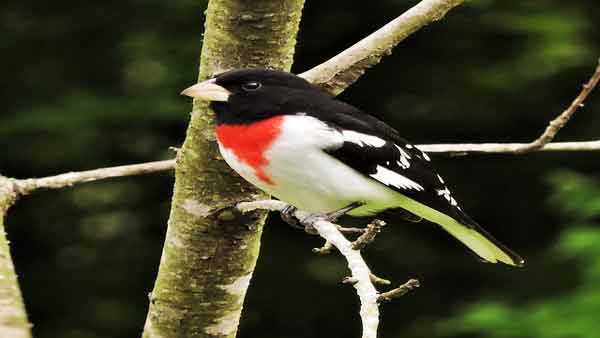
Birdwatching is a popular pastime for nature enthusiasts worldwide and good reason. There are over 10,000 species of birds in the world, each with unique features and behaviors.
In this post, we will focus on 11 small black and white birds that are particularly interesting and unique. These birds come from various families and habitats but share striking black-and-white coloring. Black and white birds are especially appealing to birdwatchers, as their contrasting colors make them easy to spot and identify in the wild.
11 Small Black and White Birds (With Pictures)
1. Black Capped Chickadee
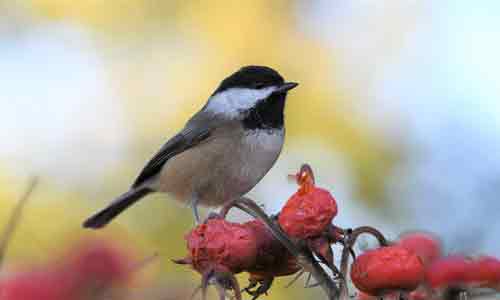
The Black Capped Chickadee is a small bird found in North America. It is known for its distinctive black cap, bib, and white cheeks. The Black Capped Chickadee is a non-migratory bird found in various habitats, including jungles, parks, and suburban areas.
This bird feeds on insects and seeds and is known for its acrobatic movements as it hops from branch to branch.
Fun fact: Black Capped Chickadees can store thousands of sources in hiding places to eat later.
2. White-Breasted Nuthatch
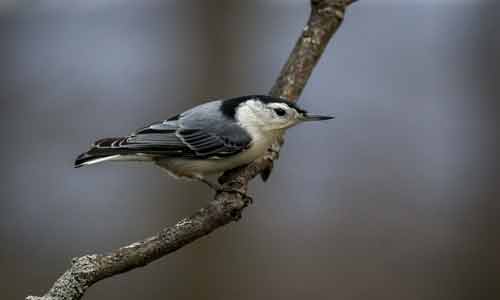
The White-Breasted Nuthatch is a small bird that is found in North America. It is known for its white belly and face, as well as it’s black and blue-gray back. This bird is found in forests and woodlands, feeding on insects and seeds. The White-Breasted Nuthatch is known for its distinctive habit of creeping down tree trunks headfirst
Fun fact: White-Breasted Nuthatches mate for life and often return to the same nesting site each year.
3. Rose-Breasted Grosbeak
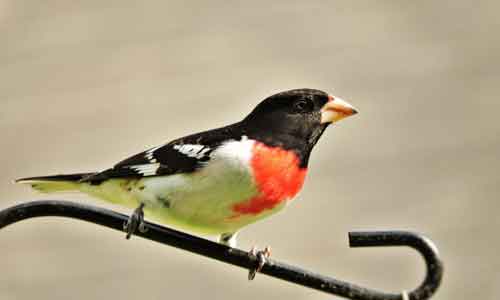
The Rose-Breasted Grosbeak is a medium-sized bird that is found in North America. It is known for its striking black and white coloring, as well as its bright red breast. This bird is found in forests and woodlands, feeding on insects, seeds, and fruit.
The Rose-Breasted Grosbeak is known for its beautiful song, often described as sounding like a robin’s song with a burry quality.
Fun fact: Male Rose-Breasted Grosbeaks are known for their unique courtship display, where they spread their wings to reveal their bright red breast.
4. Black-Necked Stilt
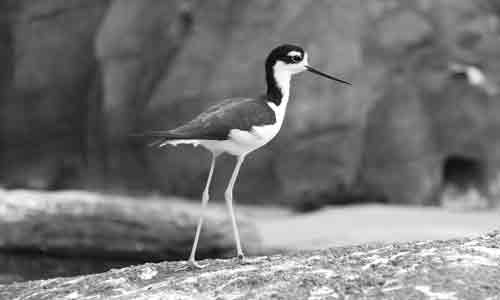
The Black-Necked Stilt is a small bird found in North and South America. It is known for its long, thin legs and distinctive black and white plumage.
This bird is found in wetlands and marshes, where it feeds on insects and small crustaceans. The Black-Necked Stilt is known for its graceful movements as it walks through the water on its long legs.
Fun fact: Black-Necked Stilts often lay their eggs directly on the ground without building a nest.
5. American Oystercatcher
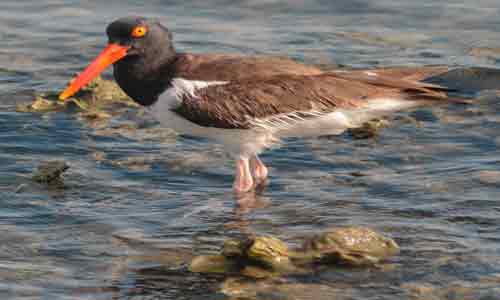
The American Oystercatcher is a large bird that is found on the coast of North and South America. It is known for its black-and-white coloring and long, bright orange bill.
This bird is found on beaches and in salt marshes, where it feeds on shellfish and other invertebrates. The American Oystercatcher is known for its loud, piercing calls heard from a distance.
Fun fact: American Oystercatchers mate for life and often return to the same nesting site each year.
6. Blackpoll Warbler
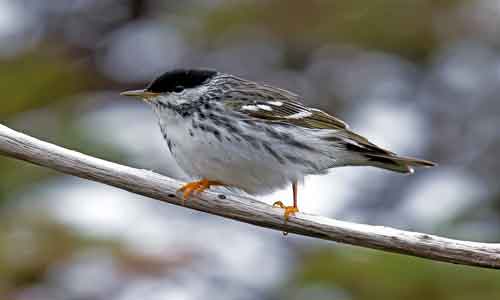
Meet the Blackpoll Warbler, a small but mighty black and white bird known for its incredible migration journey. This bird is typically around 5 inches long and weighs less than half an ounce. Its black and white plumage is striking, with bold black streaks on its white underparts and a black cap on its head. The male also has a black cheek patch that sets it apart from the female.
Blackpoll Warblers breed in the forests of Canada and Alaska but migrate south to the Caribbean and South America for the winter. They are known for their incredible non-stop migration, flying up to 2,500 miles over the open ocean in just a few days. During migration, they can often be found in parks and gardens, where they forage insects and berries.
7. Black-billed Magpie
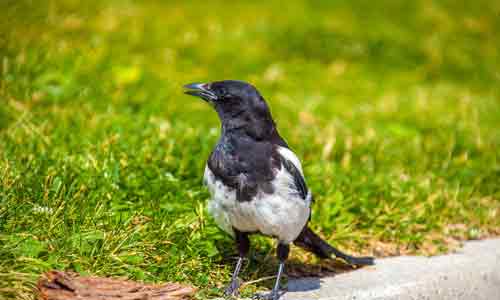
The Black-Billed Magpie is a large, striking black-and-white bird in western North America. This bird is around 18 inches long and has a wingspan of up to 2 feet. Its black and white plumage is distinctive, with a black head, wings, tail, white belly, and shoulders.
Black-Billed Magpies are known for their intelligence and boldness, and they are often found around human settlements. They are omnivores, feeding on various food, including insects, small mammals, fruits, and seeds. They are also known for their unique vocalizations, including a chattering and raucous, croaking call.
8. Downy Woodpecker
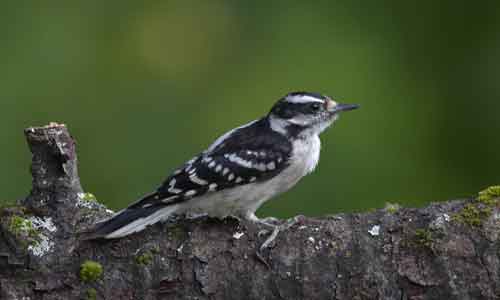
Meet the Downy Woodpecker, a small, energetic black and white bird in North America. This bird is around 6 inches long and has a wingspan of up to 11 inches. Its black and white plumage is similar to that of the larger Hairy Woodpecker, but the Downy Woodpecker has a shorter bill and is more compact.
Downy Woodpeckers are found in various habitats, including woodlands, parks, and backyards. They are known for their ability to cling to trees and feed on insects and other invertebrates. They also eat seeds and fruits and are often attracted to bird feeders.
9. Acorn Woodpecker
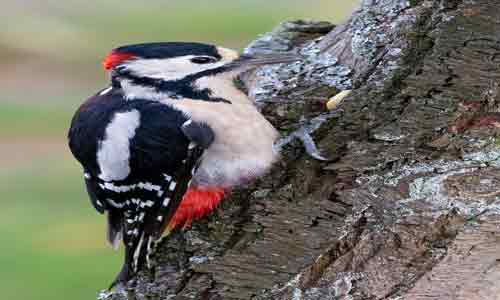
The Acorn Woodpecker is a unique black and white bird in western North America. This bird is around 9 inches long and has a wingspan of up to 17 inches. Its black and white plumage is distinctive, with a black head, wings, back, and a white belly and forehead.
Acorn Woodpeckers are known for their unique feeding habits, where they store acorns and other nuts in holes they have drilled in trees. They are also social birds, living in groups of up to 15 individuals. They communicate with each other using a range of calls and drumming sounds.
10. Black Phoebe
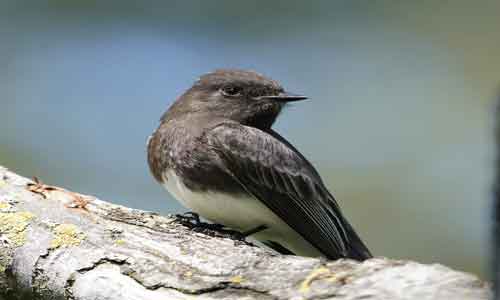
Meet the Black Phoebe, a small, charming black and white bird in western North America. This bird is around 7 inches long and has a wingspan of up to 11 inches. Its black and white plumage has a black head, back, tail, and white belly.
Black Phoebes are often found near water, where they forage insects and other small invertebrates. They are known for their distinctive call, a clear “phoebe” sound. They are also cavity nesters, often building their nests in crevices in buildings or other artificial structures.
11. Royal Tern
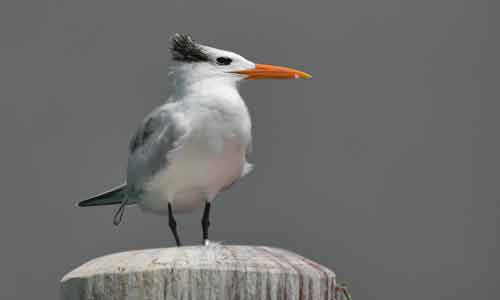
The Royal Tern is a stunning black and white bird found along the coasts of North and South America. It has a distinctive crest on its head, a bright orange bill, and a long tail. This bird is known for its graceful flight and habit of diving into the water to catch fish.
It is an important species in coastal ecosystems, helping to control fish populations and contributing to the environment’s overall health. The Royal Tern faces habitat loss and human disturbance threats despite its importance. Conservation efforts are needed to protect this beautiful small black and white bird for future generations.
Most importantly
In conclusion, small black and white birds are some of the most interesting and unique species in the avian world. From the striking Rose-Breasted Grosbeak to the nimble Blackpoll Warbler, each bird has its fascinating physical features, habitat, diet, and behavior.
While some of these birds may be more common than others, they are worth learning about and appreciating for their important role in the ecosystem—the joy they bring to birdwatchers and nature enthusiasts alike.
If you want to spot beautiful black and white birds, grab a pair of binoculars and head to your nearest birding hotspot. And remember, protecting these species and their habitats is crucial for their survival and the health of our planet
Also Read:-
- 15 Beautiful White Birds Species (With Pictures)
- 15 Beautiful Birds With Red Heads (With Pictures)
- 14 Beautiful Pink Birds (With Pictures)
- Top 10 Birds with Long Beaks (With Pictures)
- 10 Amazing Birds Long Legs (With Pictures)
- 7 Best Pet Birds That Talk for Beginners